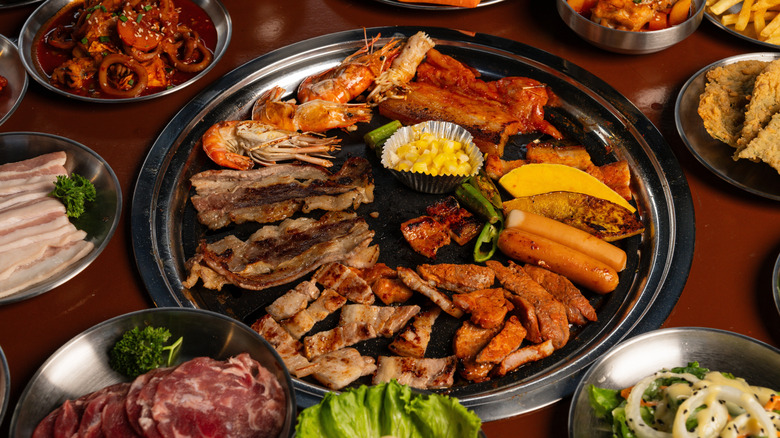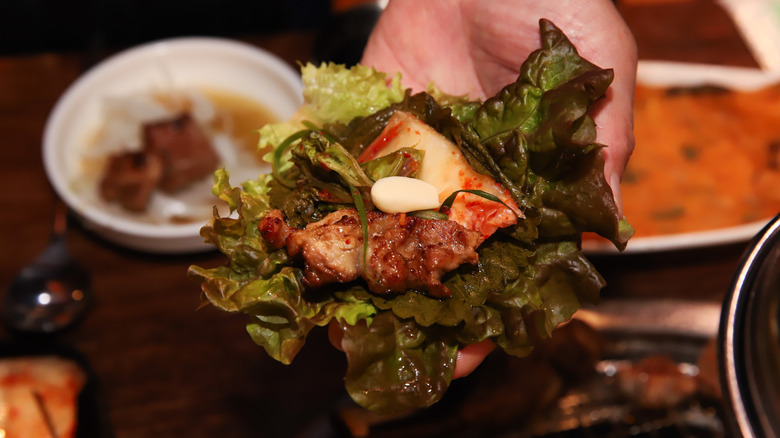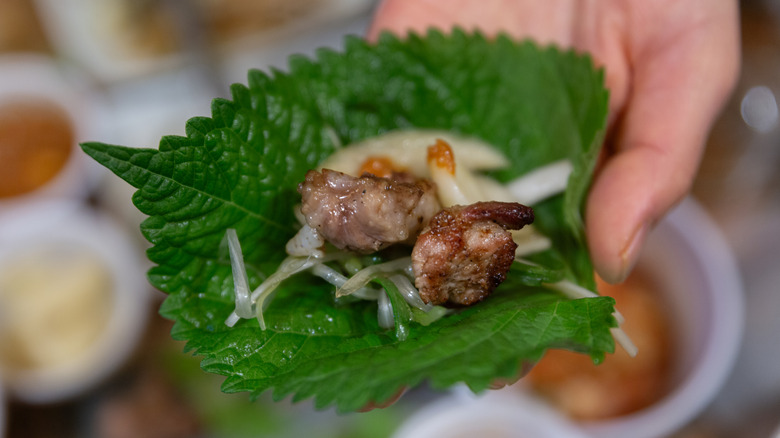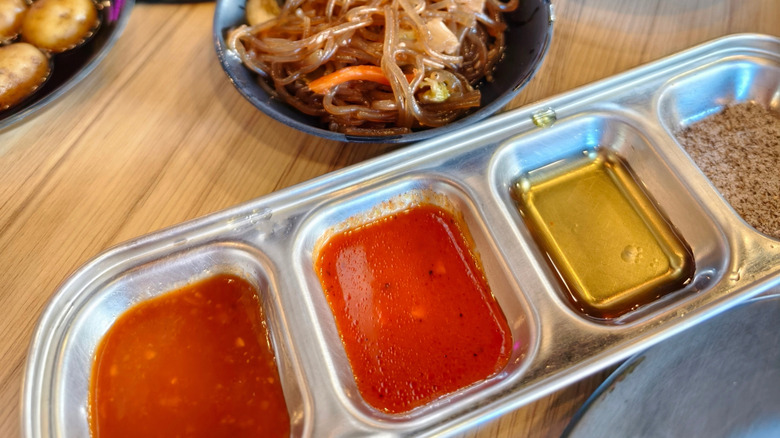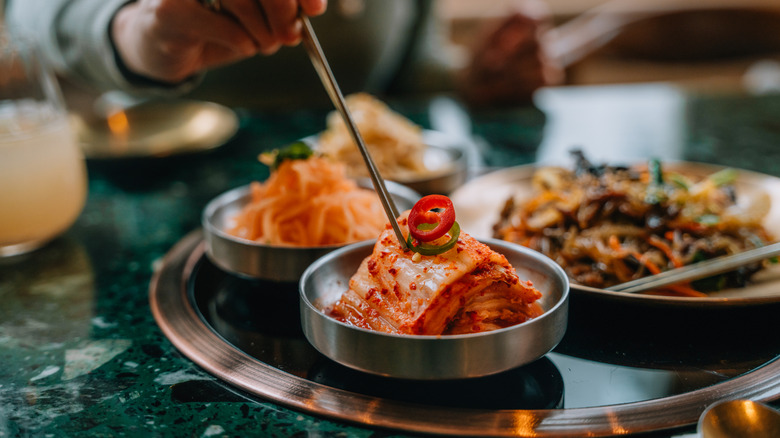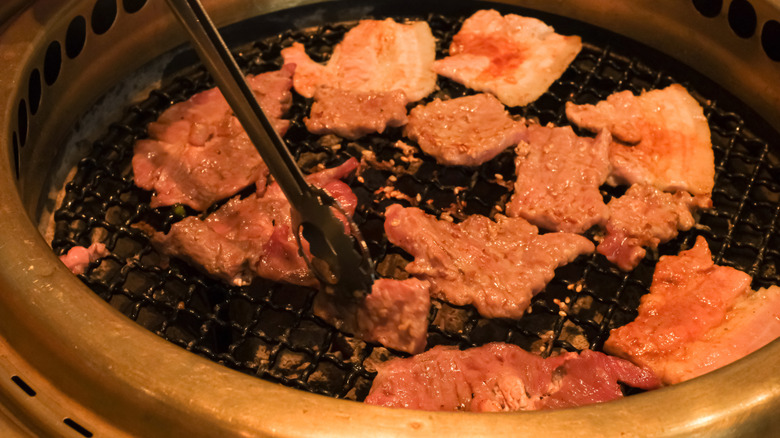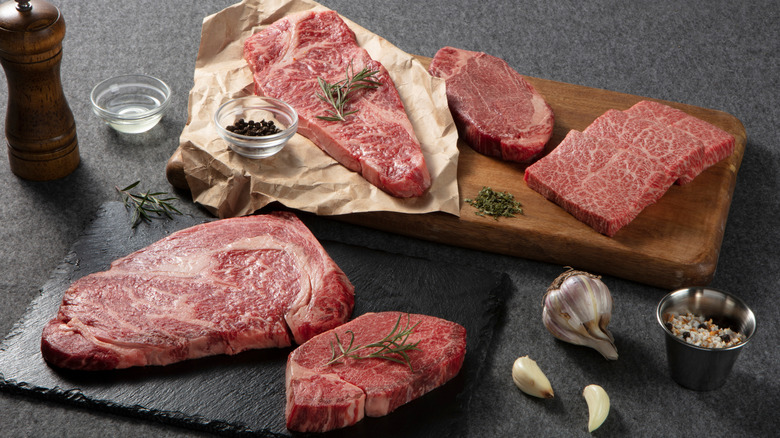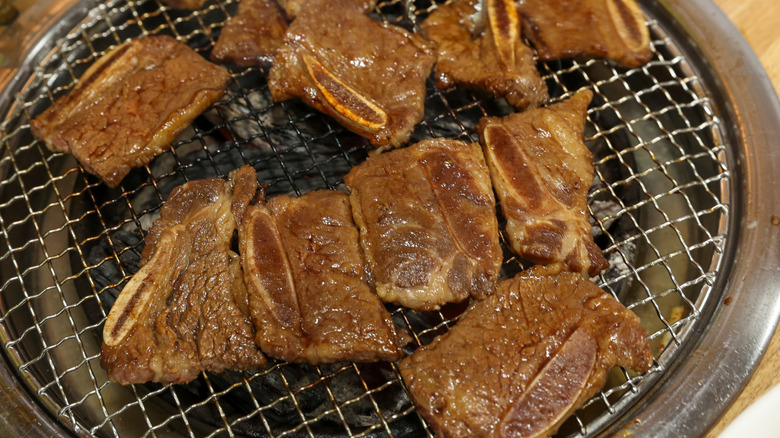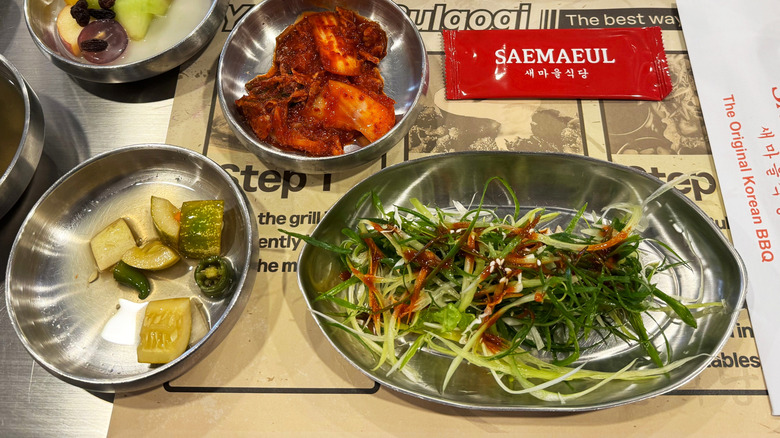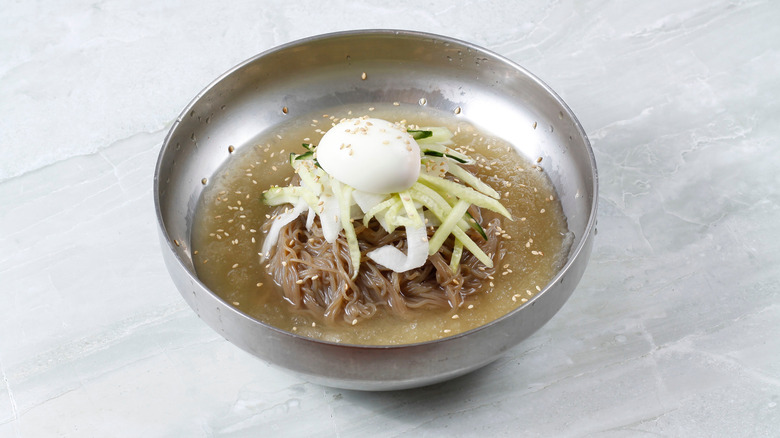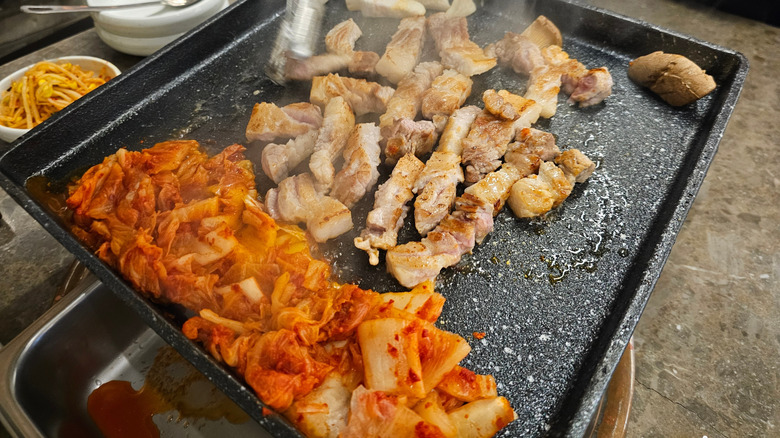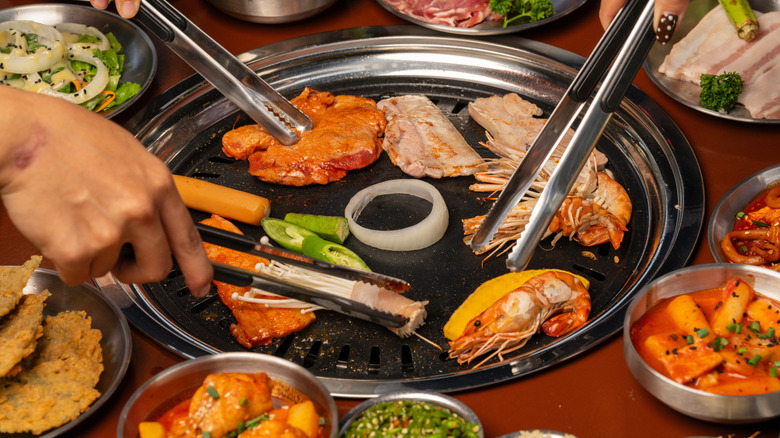Korean BBQ 101: Experts Reveal The Top Rules First-Time Diners Always Get Wrong
Korean BBQ is undoubtedly the most popular part of Korean cuisine in the United States. After all, Americans love their meat, as evidenced by our love of steakhouse chains. Unlike steakhouses, though, Korean BBQ is a communal experience. It involves cooking slices of meat on a grill at the center of your table, and enjoying them with various side dishes and vegetables together with everyone. When the meat is almost done grilling, it's typically cut into bite-size pieces. If this is your first time going to a Korean BBQ restaurant, it can seem a little overwhelming being in an unfamiliar setting. We're here to help.
You should familiarize yourself with some key words and phrases to know at a Korean BBQ restaurant, but there's more to it than that, so we gathered some advice for you to follow. The Daily Meal interviewed experts from two Korean BBQ restaurants in Los Angeles. The first is Chef Solomon Lee from Gabin Korean Grill, a high-end Korean BBQ restaurant, and Joon Lee, the head server at ORIGIN Korean BBQ, a spot inspired by 1960s Seoul. The two gave us the rules and tips that Korean BBQ first-timers tend to get wrong, so you'll be well-equipped to enjoy your first Korean BBQ feast. There are different types of Korean BBQ restaurants, from all-you-can-eat places to a la carte restaurants that showcase more quality cuts, but the tips and rules below will apply no matter what kind you're at.
Make a wrap (ssam)
One thing that many Korean BBQ first-timers miss out on is enjoying the grilled meat as a ssam, or a wrap. Instead, many first-timers end up eating the meat by itself and end up missing out on the true experience. Traditional Korean BBQ restaurants will serve lettuce or rice paper that can be used to wrap the meat in. The rice paper looks like a stack of white squares, and you'd have to peel each thin layer. The rice paper is slick and chewy. ORIGIN also serves sesame leaves (also called perilla leaves or shiso) for wrapping purposes, though this is an option that's harder to find in the U.S.
"It's very important not to just be eating the meat," says Solomon Lee. "You want to have the whole experience." To make a proper ssam, you shouldn't just wrap the meat in lettuce, but also use some of the banchan and condiments. Lee recommends putting the meat, some ssamjang (marinated soy bean paste), some fresh garlic, and peppers on top of a piece of lettuce or rice paper, and packing it together using the lettuce or rice paper as the wrapper. You can also put some of the banchan inside the wrap. You can then eat the entire wrap, enjoying all the components in one bite. Ssam is a traditional way of enjoying Korean BBQ, and the vegetables certainly make for a healthier and more well-balanced meal than just eating tons of grilled meat alone.
Wrap the ssam into bite-size pieces
Solomon Lee also has another tip for making ssam correctly — it should be a one-bite affair. This is one thing that many non-Koreans get wrong. People tend to make a big wrap full of meat and then take multiple bites out of it, but that is not the proper way to eat ssam. "You don't want to be nibbling at it," says Lee, "it's not a two-bite thing." That's why you should not overpack the wrap. "If it looks like it's too big to fit in your mouth, it probably is."
What if you're served large leaves of lettuce, though? Your first instinct may be to use each leaf for a whole ssam, but there's a better way. Joon Lee explains that in Korean dining, people usually break large leaves into smaller pieces. Perilla leaves and rice paper usually already come in the right size to make a one-bite wrap, but you can also tear the lettuce to get a piece that's just the right size. Pack enough meat and other condiments to fit nicely into your mouth, and create the perfect bite according to your preferences.
Experiment with dipping sauces
At many Korean BBQ restaurants, they will lay out different dipping sauces and salt for each guest. Each restaurant may serve different sauces, but traditionally, there's usually a soy-based sauce that may or may not have a slice of serrano or jalapeno pepper, marinated soy bean paste (ssamjang), some sort of chili sauce, sesame oil, and salt. Some newer Korean BBQ restaurants may get creative, though, including other condiments like chimichurri, and it's always fun to experiment with them.
Solomon Lee emphatically recommends asking your server "what sauces are for what." The servers at places like Gabin and ORIGIN are more than happy to recommend some sauce pairings that they think go particularly well together. If you're in a time crunch and the servers aren't available, Lee has some pro tips to give: Salt for ribeye or any cut that you feel is a premium cut of meat (since you don't want to cover up the flavor of the meat with anything stronger), the soy based dipping sauce for bulgogi, and sesame oil and salt for pork belly. Lee also mentions that you can always ask for sesame oil and salt if it's not automatically served, since all Korean kitchens should have those ingredients handy. Funnily enough, Joon Lee mentions seeing people "just sprinkle [salt] on top of the meat while they're grilling," though that's certainly not the traditional Korean way.
Get banchan refills
Like most Korean restaurants, Korean BBQ places also serve banchan. These are the small bowls or plates filled with accompanying dishes like kimchi, fish cakes, vegetables, and other things that are laid out on the table when you arrive. Any Korean meal is typically accompanied by some banchan.
While most of us can't help but start nibbling on them before our main order arrives, banchan dishes are not appetizers. Instead, banchan is meant to be eaten with your main course (or in this case, to complement your grilled meats). Once you taste a bit of each one, you will inevitably find your favorite banchan or two. Even if everyone on your table likes the same banchan, don't worry about running out. At most restaurants, banchan dishes come with free refills, so you can always ask for more throughout your meal and share with everyone on the table.
Remember to try the different banchan dishes with your meat or as part of your ssam. Traditional banchan include things like kimchi and bean sprout salad, but Korean BBQ restaurants in particular have incorporated some modern options. A popular Korean BBQ banchan these days is corn cheese, made of corn with melted cheese and mayonnaise. It's so good you may want to get seconds!
Don't flip the meat too many times
One thing that both Solomon Lee and Joon Lee see often is that people tend to flip their meats way too often when they're grilling. Since you're looking at the meat in front of you and waiting for it to be ready, it can be tempting to keep flipping it. How many times one should flip the meat while grilling a steak is controversial, though. Many have said for a long time that you should only flip the meat once to "seal" the juices and get a good sear, but experts now say that you should flip steak more frequently because it cooks the meat more evenly.
For Solomon Lee and Joon Lee, though, they are in the camp that believes that you should not flip any meat too many times, but that doesn't necessarily mean you should only flip it once. According to Joon Lee, they usually flip the meat three times at ORIGIN. Even for thin meats like brisket (bulgogi), they would only flip it three times. If you prefer a nice char on your meat, less frequent flipping will also work well for your taste.
Don't save the best for last: Start with the premium cuts
Korean BBQ restaurants offer many different cuts of meat, from short rib to ribeye to brisket and more, with a lot of them also offering different types of meat, including pork, chicken, and seafood. Both all-you-can-eat and à la carte restaurants offer many options for beef cuts, and à la carte restaurants often offer combos for two or more people. These combos let you try more cuts of meat at a more affordable price. Even though most of us have our favorite cuts, it's still good to get a variety to enjoy during dinner.
There's actually a commonly accepted order of which types of meat you should grill and enjoy first. Solomon Lee recommends starting out with the best cuts, like kkotsal, which means "flower meat" and refers to a boneless short rib cut, or ribeye. By starting with the best cuts first, you can enjoy the flavor to the fullest, before you're too full from other dishes or your palate is saturated by different flavors. Lee suggests starting with the two cuts above, then moving on to brisket (bulgogi). Joon Lee, on the other hand, says that at ORIGIN, they would usually grill the thinner meats like the brisket first, then move on to the fattier meat at the end. However, both agree that you should start with unmarinated meats first.
Grill and eat the marinated meats last
While marinated short rib, or galbi, may be what most people think of when they think of Korean BBQ, that should be eaten last as far as the beef course goes. There are a couple of reasons for this. "If you enjoy the marinated beef first, it's going to ruin your grill," explains Solomon Lee. The sugar in the galbi marinade burns and caramelizes easily and quickly, which sticks to the grill and will ruin the flavor of any other meats that you cook on that grill afterwards.
Sure, some Korean BBQ restaurants will change out your grill to a clean one when this happens, but the strong flavor of the marinated beef will also ruin your own palate. Lee says you should enjoy the meat without marinade first, "so you're able to taste that as is, and then you finish off with a marinated beef." Lee also says that if your group also wants to enjoy some pork, you should wait after all the beef courses are done.
Experiment with different banchan in your ssam
Making a great ssam isn't just wrapping the grilled meat in lettuce or rice paper. You should also complement the meat with some of the banchan offered by the restaurant. While there are recommended items that the restaurant staff think go well together, Joon Lee notes, "we do ask [customers] just to get creative about it." After all, being able to try different combinations of the various dipping sauces and banchan is part of what makes Korean BBQ a fun dining experience.
Kimchi is an obvious choice, of course, but another banchan that Koreans particularly love to enjoy together with their grilled beef is called pa muchim. "A lot of Korean BBQ restaurants have a scallion type of mix," says Solomon Lee, "dressed up in sesame oil and vinegar and red pepper. You want to enjoy that too." Pa Muchim is a kind of salad made from long strips of thinly sliced scallions, which are typically tossed with gochugaru (Korean red chili powder) and sesame oil, though it can also incorporate other ingredients depending on the recipe.
Get some side dishes
Another tip Solomon Lee has is for people to enjoy the side dishes that Korean BBQ restaurants offer, and he's not just talking about banchan. Many Korean BBQ restaurants will have side dishes like doenjang jjigae (soybean paste stew) or kimchi jjigae (kimchi stew). These stews usually also contain thin slices of meat along with zucchini and other vegetables. At many à la carte restaurants, one or the other stew will be offered as part of a combo.
Gabin and ORIGIN both serve the ice-cold naeng-myeon noodles, a Pyongyang-style dish that Gabin is particularly well-known for. "They're there for a reason, and they're there to complement the entire meal," Solomon Lee says about side dishes. Many Koreans eat side dishes like the stew and cold noodles after they're done with the meat, but you can certainly enjoy them throughout the meal. Lee has a pro-tip for those dining at Gabin, though: Eat the cold noodles together with the marinated short ribs. "It's really good if you take the short rib ... while you're enjoying the cold noodles," says Lee. "You want to wrap the meat with the noodles [and] eat it together."
Grill your kimchi next to the pork belly
One thing you should certainly try at any Korean BBQ restaurant is the kimchi. After all, kimchi is a key sign that will tell you if a Korean BBQ restaurant is good or not. Both Solomon Lee and Joon Lee recommend grilling it with pork belly, a combination that Solomon Lee describes as "top-tier." If you don't usually like kimchi, give it another try after it's grilled. You may just change your mind.
For people who don't like kimchi because it's spicy, "if you put it on the grill and cook it, the spice is gone," says Joon Lee. It also happens to go very well with the pork belly itself. The oil from the pork belly drains off to the side onto the kimchi, which helps cut the spiciness, while the acidity of the kimchi goes well with the richness of the pork belly. "That makes the flavor really good," says Joon Lee.
Stir-fried pork and kimchi is actually a common Korean dish, so it's a popular combo, and certainly a beloved one. While many Korean BBQ goers tend to focus on the beef, you should also consider saving some room for pork, especially the pork belly. Just remember to save the pork belly until all the beef courses are done.
Korean BBQ is a communal experience
Korean BBQ is best enjoyed with a group of people sharing the meal together. Having more people also allows you to order more different cuts of meat. As a solo diner, there's only so much you can eat, after all. There are some unofficial rules for Korean BBQ dining in a group setting. In Korean culture, if you're in a professional setting, then the youngest person in the group will do the grilling. This unspoken rule is done as a sign of respect. If you're with a group of friends, though, most of the time it becomes the job of the person who's best at grilling, though it's probably good to take turns out of fairness.
In Korea, people have no problem using their chopsticks to flip and pick up the meat on the grill. In the U.S., however, people are more reserved about sharing, so pretty much all Korean BBQ restaurants will provide tongs that you can use to cook and flip the meat, as well as serve the pieces to everyone. There will also be kitchen scissors provided, so you can cut the larger pieces of meat into bite-size pieces. This way, everyone in the group can get at least a few small pieces.
